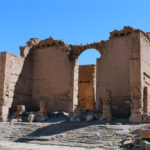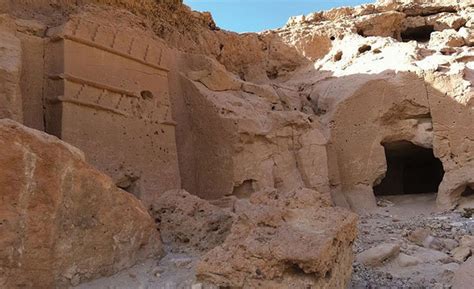
The kingdoms of southern Yemen established guard posts along all the caravan routes to protect the convoys against bandits and harassment by the tribes on the way. It may be that the people of Yathrib, who trace their lineage back to Yemen, were planted by the Sabaeans in this place in order to protect their caravans headed for the Levant.[1] Historians estimate that caravans transported about three thousand tons of incense and myrrh annually.[2]
BY THE END of the first century AD maritime trade via the Red Sea was flourishing because it was cheaper than caravans, and a single ship could carry what would require several land caravans. This is confirmed by the fact that the last reference to caravans dates from the end of the first century AD.[3]
If present-day Makka was neither known nor important before the advent of Islam, where was the Ka‘ba to which pre-Islamic Arabs made their pilgrimage? Dan Gibson has provided more than ten geographical, historical and religious proofs demonstrating that the Ka‘ba was located in the historic city of Petra, whose ruins are still found in the desert south of Jordan. The following are some of these proofs:
1- Ibn Hisham records in the Sīra (‘biography’) of the Prophet that
“It happened that ‘Abdullah [the father of the Prophet of Islam] went into a woman that he had beside Āmina bint Wahb when he had been working in clay and the marks of the clay were on him. She put him off when he made a suggestion to her because of the dirt that was on him. He then left her and washed and bathed himself. And as he made his way to Āmina he passed her and she invited him to come to her. He refused and went to Āmina, entered her and she conceived Muḥammad.”[4]
It is likely that the cave of Ḥirā’ was located in the mountains of Petra
It is known that Makka in the Hijaz lies in a sandy desert that has no access to water other than the well of Zamzam, and that it has no farms or clay land. According to the Qur’an, Abraham said,
Lord! Lo! I have settled some of my posterity in an uncultivable valley near unto Thy holy House, our Lord! [Qur’ān, XIV (Ibrāhīm), 37].
If ‘Abd Allah had been working in one of his fields and was covered with mud, this must have been somewhere other than Makka. This place was Petra, which palaeontologists have ascertained had fruit trees, grapes, farms and streams of running water. The archaeologist Diana Kirkbride-Helback, after excavations conducted between 1958 and 1967 in a village five kilometers from Petra, discovered the existence of grain stores, and concluded that the domestication of grain may have taken place for the first time in this patch of land.[5]
2 – The Well of Zamzam: The Old Testament tells us that the Zamzummīm[6] were a people of giants people living in the land of Edom and the land of Ammon, and that these tribes lived in northern Arabia near the city of Petra.[7] If we want to look for the Zamzam well, we should look for it in the Petra area, where the Zamzummīm tribes lived. Among none of the Arab tribes or in their pre-Islamic poems is there a famous tribe or person whose name was Zamzam. Where then did the name of the well of Zamzam come from if not from this tribe that lived in the Petra region?
3 – The cave of Ḥirā’: The cave of Ḥirā’ in present-day Makka is a matter of rock slabs piled one upon each other with an opening on one side, but it is not a cave in the sense of caves we know, whereas the city of Petra is surrounded by mountains that contain several real caves, and it is likely that the cave of Ḥirā’ was located in these mountains.
4- The tribes that the Qur’ān mentions most of all – ‘Ād, Thamūd, and Madyan – lived in northern Arabia, specifically in the areas surrounding the city of Petra. The Prophet of Islam must have been speaking to a group of people who knew the stories of these tribes because of their proximity to them.
5- When ‘Abd al-Muṭṭalib the grandfather of the Prophet of Islam, set out to dig the well of Zamzam. Ibn Hishām reports that
he took a pickaxe and went with his son Al-Ḥārith ibn ‘Abd al-Muṭṭalib, – for he had no other son at the time – and began to dig. When the top of the well appeared, he cried “Allahu Akbar”! Thus, Quraysh knew that he had obtained his object and they came to him, and said, “This is the well of our father Ismā‘īl and we have a right to it, so give us a share in it”. … They said, “Do us justice, for we shall not leave you until we have got a judicial decision in the matter.” He said, “Appoint anyone you like as umpire between us”. He agreed to accept a woman diviner of Banū Sa‘d Hudhaym who dwelt in the uplands of Syria.[8]
Logic says that the well of Zamzam was located in Petra, which is only a few kilometers from the Levant
If this version is true, and ‘Abd al-Muṭṭalib was in present-day Makka when he dug the well, was it reasonable for the Makkans to ask him to seek to resolve the dispute with a priestess of Banū Sa‘d in Syria, more than seven hundred kilometers from Makka, at a time when Makka and its surroundings were awash with priests, it being the pilgrimage complex for all Arabs in the peninsula? Logic says that this well was located in Petra, which is only a few kilometers from the Levant, and therefore permitting the resort to a priestess of Banū Sa‘d.
6- In his work Al-Zumurrud Ibn al-Rāwandī says that Muḥammad’s night journey (al-Isrā’) from Makka to Jerusalem was not a miracle because the two towns were close to each other, and any person on a horse could travel from Makka (Petra) to Jerusalem and return the same night.[9] This means that Muḥammad was in Petra.
7- Sūrat al-Baqara, 144: “Indeed We see the turning of your face to heaven, so We shall surely turn you to a qiblah which you shall like; turn then your face towards the Sacred Mosque, and wherever you are, turn your face towards it, and those who have been given the Book most surely know that it is the truth from their Lord; and Allah is not at all heedless of what they do.”

Suggested Reading
This was the first sūra that Muḥammad produced following his migration to Yathrib. According to traditional Islamic works, Muḥammad prayed over sixteen months to a qibla not specified in the Qur’ān, but according to these works was pointed towards Jerusalem. It is worth noting here that the Qur’ān says “turn then your face towards the Sacred Mosque” while Makka did not have a mosque at that time. Traditional books inform us that the word ‘mosque’ means ‘meeting place’. Even if we accept this definition, the same traditional books tell us that the Quraysh used to gather in the Dār al-Nadwa (‘Assembly House’):
When the Makkans heard of it, they got out of his way. Quraysh said among themselves, “Muḥammad and his companions are in destitution, want and privation.” Ibn Ḥamīd relates that “they gathered at the door of the assembly house to look at him and his companions”.[10]
If the mosque is the ‘meeting place’, it means that Allah has commanded His Messenger to pray towards the Dār al-Nadwa because it is the meeting place of the Quraysh, and not the Ka‘ba.
[1] Dan Gibson, Quranic Geography, p.1022. View this book in the Almuslih Library here.
[2] Dan Gibson, Op. cit., p.161.
[3] Greg Fisher, Arabs and the Empires before Islam, Oxford -18 University Press, 2015, p.71.
[4] Ibn Hisham, السيرة النبوية – دار الصحابة للتراث بطنطا، الطبعة الأولى، 1995 المجلد الأول, p.205.
[5] Dan Gibson, Op. cit., p.276
[6] Deuteronomy, II, 20: רְפָאִים יָשְׁבוּ-בָהּ, לְפָנִים, וְהָעַמֹּנִים, יִקְרְאוּ לָהֶם זַמְזֻמִּים (‘Rephaim dwelt therein aforetime; but the Ammonites call them Zamzummim’).
[7] Dan Gibson, Op. cit., p 278.
[8] Ibn Hisham, Op. cit., p.193.
[9] Dan Gibson, Op. cit. p.285.
[10] Tārīkh al-Ṭabarī, Vol. 1, p. 142. See also Ibn Hisham, السيرة النبوية – دار الصحابة للتراث بطنطا، الطبعة الأولى، 1995 المجلد الأول, tr. Alfred Guillaume, p.530.
Main image: The well of Zamzam located within the Masjid al-Ḥaram in Makka. Held in Islamic tradition to have opened up thousands of years ago when Ismā‘īl (Ishmael) was left with his mother Hajar in the desert. After having dried up ‘Abd al-Muṭṭalib is to have rediscovered it in the 6th century.


